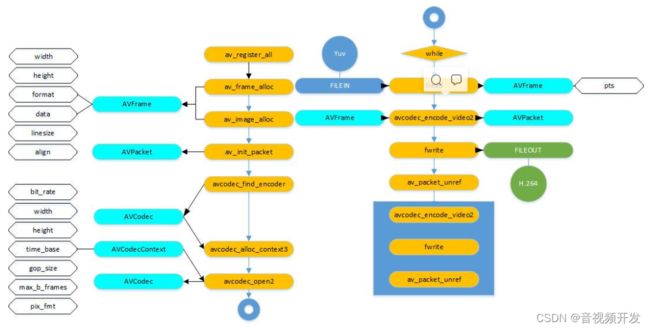FFmpeg将YUV420P格式数据编码成H.264
一、编码流程
本文福利, 免费领取C++音视频学习资料包、技术视频,内容包括(音视频开发,面试题,FFmpeg ,webRTC ,rtmp ,hls ,rtsp ,ffplay ,编解码,推拉流,srs)↓↓↓↓↓↓见下面↓↓文章底部点击免费领取↓↓
二、代码实现
/*---------------------------------------------------------
* 文件名:transfer.c
* 文件说明:实现YUV数据编码成H.264文件
* 作者:hzg
* 修改记录:
* 1、修改了申请图像内存的对其数值,由原来的32位对齐修改为16位对齐,解决了编码成H.264文件之后播放绿屏乱码问题
* 2、编码第22帧的时候,才开始将包置为1,编码延迟较久。疑似编码选项av_opt_set问题
----------------------------------------------------------*/
#include
#include
#include
#include
#include
#include
#include
#include
#include
#include
#include
#include
char * prename = "TestPre";
char * outname = "TestOut";
char * out_r = NULL;
int framenum = 0;
int main(int argc, char **argv)
{
AVFrame *frame;
AVCodec *codec = NULL;
AVPacket packet;
AVCodecContext *codecContext;
int readSize=0;
int ret=0,getPacket;
FILE * fileIn,*fileOut;
int frameCount=0;
/* register all the codecs */
av_register_all();
if(argc!=4){
fprintf(stdout,"usage:./test_ffmpeg xxx.yuv width height\n");
return -1;
}
//1.我们需要读一帧一帧的数据,所以需要AVFrame结构
//读出的一帧数据保存在AVFrame中。
frame = av_frame_alloc();
frame->width = atoi(argv[2]);
frame->height = atoi(argv[3]);
fprintf(stdout,"transf para width=%d,height=%d\n",frame->width,frame->height);
frame->format = AV_PIX_FMT_YUV420P;
//根据指定的宽,高,和像素格式申请图像内存,最后一个参数表示内存对齐的值,32位对齐4字节,导致352*288时候绿屏,尝试修改成16位对齐
//修改成16位对齐之后
av_image_alloc(frame->data,frame->linesize,frame->width,frame->height,frame->format,16);
fileIn =fopen(argv[1],"r+");
//2.读出来的数据保存在AVPacket中,因此,我们还需要AVPacket结构体
//初始化packet
av_init_packet(&packet);
//3.读出来的数据,我们需要编码,因此需要编码器
//下面的函数找到h.264类型的编码器
/* find the mpeg1 video encoder */
fprintf(stdout, "find encoder AV_CODEC_ID_H264\n");
codec = avcodec_find_encoder(AV_CODEC_ID_H264);
if (!codec) {
fprintf(stderr, "Codec not found\n");
exit(1);
}
//有了编码器,我们还需要编码器的上下文环境,用来控制编码的过程
codecContext = avcodec_alloc_context3(codec);//分配AVCodecContext实例
if (!codecContext)
{
fprintf(stderr, "Could not allocate video codec context\n");
return -1;
}
//设置编码器参数控制编码
/* put sample parameters */
codecContext->bit_rate = 400000; //参数为400000的时候,编码出来的busH264文件为254KB
/* resolution must be a multiple of two */
codecContext->width = 352; //输入文件bus是CIF格式,YV12 352*288
codecContext->height = 288;
/* frames per second */
codecContext->time_base = (AVRational){1,25};
/* emit one intra frame every ten frames
* check frame pict_type before passing frame
* to encoder, if frame->pict_type is AV_PICTURE_TYPE_I
* then gop_size is ignored and the output of encoder
* will always be I frame irrespective to gop_size
*/
codecContext->gop_size = 10; //每10帧发送一帧I帧
/*
* vcodec_encode_video2函数输出的延时仅仅跟max_b_frames的设置有关,
* 想进行实时编码,将max_b_frames设置为0便没有编码延时了
*/
codecContext->max_b_frames = 1; //每两个非B帧之间最多一个B帧
codecContext->pix_fmt = AV_PIX_FMT_YUV420P;
/**
* ultrafast,superfast, veryfast, faster, fast, medium
* slow, slower, veryslow, placebo. 这是x264编码速度的选项
*/
//av_opt_set(codecContext->priv_data, "preset", "slow", 0);
av_opt_set(codecContext->priv_data, "preset", "ultrafast", 0);
//准备好了编码器和编码器上下文环境,现在可以打开编码器了
fprintf(stdout, "open encoder AV_CODEC_ID_H264\n");
if (avcodec_open2(codecContext, codec, NULL) < 0) //根据编码器上下文打开编码器
{
fprintf(stderr, "Could not open codec\n");
return -1;
}
//4.准备输出文件
fileOut= fopen("test.h264","w+");
//下面开始编码
while(1){
//读一帧数据出来
readSize = fread(frame->data[0],1,frame->linesize[0]*frame->height,fileIn);
fprintf(stdout,"fread data[0] frame->linesize[0] %d,frame->height %d,readSize %d\n",frame->linesize[0],frame->height,readSize);
if(readSize == 0){
fprintf(stdout,"end of file\n");
frameCount++;
break;
}
readSize = fread(frame->data[1],1,frame->linesize[1]*frame->height/2,fileIn);//本应该是25344,实际是27648,帧数变成146,实际150
fprintf(stdout,"fread data[1] frame->linesize[1] %d,readSize %d \n",frame->linesize[1],readSize);
readSize = fread(frame->data[2],1,frame->linesize[2]*frame->height/2,fileIn);
fprintf(stdout,"fread data[2] frame->linesize[2] %d readSize %d \n",frame->linesize[2],readSize);
//初始化packet
av_init_packet(&packet);
/* encode the image */
frame->pts = frameCount;
//将AVFrame中的像素信息编码为AVPacket中的码流,成功编码一个packet,将getPacket置位1
ret = avcodec_encode_video2(codecContext, &packet, frame, &getPacket);
if (ret < 0)
{
fprintf(stderr, "Error encoding frame\n");
return -1;
}
fprintf(stdout,"had encode %d frame,and getPacket is %d\n",framenum,getPacket); //read并encode了22帧,才开始获得一个完整编码帧
if (getPacket)
{
frameCount++;
//获得一个完整的编码帧
printf("Write frame %3d (size=%5d)\n", frameCount, packet.size);
fwrite(packet.data, 1,packet.size, fileOut);
av_packet_unref(&packet);
}
}
/* flush buffer */
for ( getPacket= 1; getPacket; frameCount++)
{
fprintf(stdout,"get flush buffer getPacket %d,frameCount %d\n",getPacket,frameCount);
fflush(stdout);
frame->pts = frameCount;
ret = avcodec_encode_video2(codecContext, &packet, NULL, &getPacket);
if (ret < 0)
{
fprintf(stderr, "Error encoding frame\n");
return -1;
}
if (getPacket)
{
printf("Write frame %3d (size=%5d)\n", frameCount, packet.size); //
fwrite(packet.data, 1, packet.size, fileOut);
av_packet_unref(&packet);
}
}
fclose(fileIn);
fclose(fileOut);
av_frame_free(&frame);
avcodec_close(codecContext);
av_free(codecContext);
return 0;
}
三、实现效果
四、FFmpeg中的YUV格式
FFmpeg视频解码后,一般存储为AV_PIX_FMT_YUV420P 的format,而解码后的数据存储在结构体 AVFrame 中。YUV420P在内存中的排布如下:
YYYYYYYY UUUU VVVV- 1
下面是我们编程时关心的重点,YUV420P在AVFrame中的存储形式,
planar YUV 4:2:0, 12bpp, (1 Cr & Cb sample per 2x2 Y samples)即存储在结构体 AVFrame 的data[ ]数组中 ,
data[0]——-Y分量
data[1]——-U分量
data[2]——-V分量
linesize[]数组中保存的是对应通道的数据宽度 ,
linesize[0]——-Y分量的宽度
linesize[1]——-U分量的宽度
linesize[2]——-V分量的宽度
这里要特别注意,linesize[0]的值并不一定等于图片的宽度,有时候为了对齐各解码器的CPU,实际尺寸会大于图片的宽度,这点在我们编程时(比如OpengGL硬件转换/渲染)要特别注意,否则解码出来的图像会异常。

